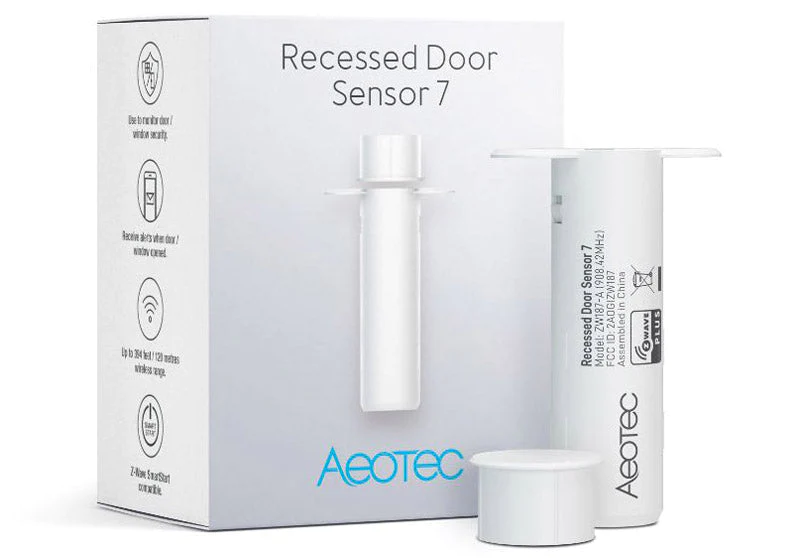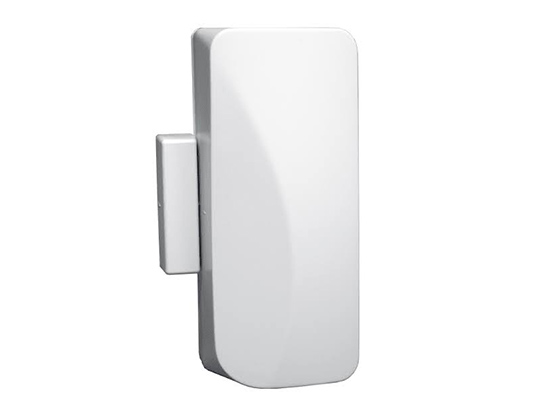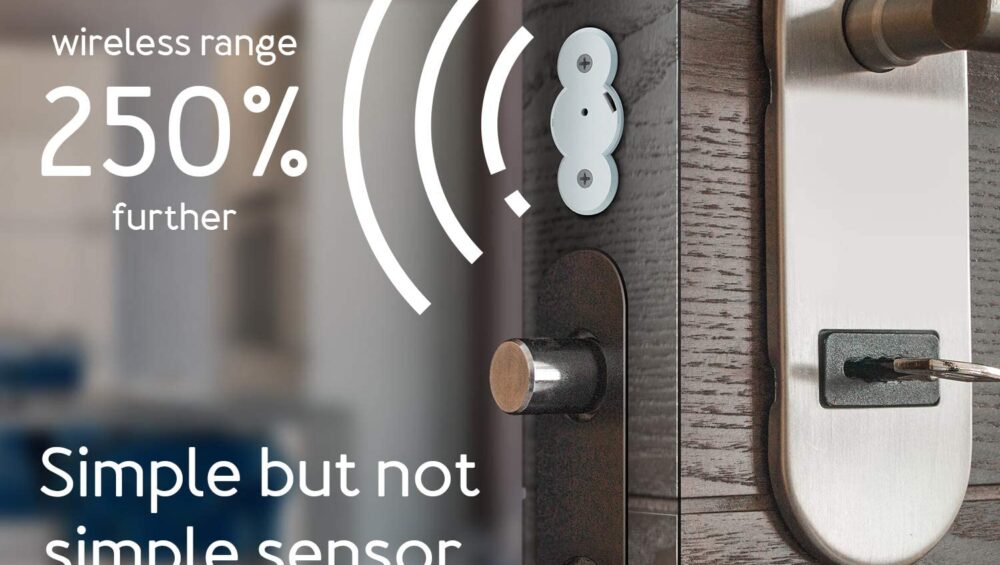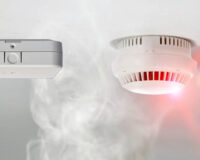- Choosing the right Z-Wave door sensor for your smart home can be overwhelming with so many options available. To help you out, I’ve compiled a list of the top 5 Z-Wave door sensors based on features, performance, and user reviews:
What is a Z-wave Door Sensor?
A Z-Wave door sensor is a smart home device designed to monitor and detect the status of doors in your home. It utilizes Z-Wave technology, which is a wireless communication protocol commonly used in home automation and smart devices. Z-Wave allows devices to communicate with each other and with a central hub or controller, creating a network of interconnected smart devices.
The Z-Wave door sensor typically consists of two main components:
- Magnetic Sensor: This part is usually attached to the door frame, and it contains a magnet. The second part of the sensor, the magnet itself, is attached to the door. When the door is closed, the magnet aligns with the magnetic sensor.
- Sensor Transmitter: This component sends signals to the Z-Wave hub or controller wirelessly when there is a change in the magnetic field, indicating that the door has been opened or closed.
The Z-Wave door sensor provides valuable information about the status of doors in your home, allowing you to monitor entry points. This information can be integrated into a broader home automation system, allowing you to receive notifications, automate other smart devices based on door status, and enhance the overall security and convenience of your home.
Benefits of Using Z-Wave Door Sensors
Z-Wave door sensors offer several benefits for homeowners, contributing to enhanced security, convenience, and automation in a smart home environment. Here are some key advantages of using Z-Wave door sensors:
- Security: Z-Wave door sensors act as an integral part of a home security system, detecting unauthorized access or intrusions. When a door is opened or closed, the sensor triggers alerts or alarms, providing homeowners with immediate notification of potential security breaches.
- Home Automation: Z-Wave door sensors seamlessly integrate with other smart home devices and platforms. This integration allows for automation scenarios, such as turning on lights, adjusting thermostat settings, or triggering surveillance cameras based on the status of the doors. This contributes to a more convenient and efficient living environment.
- Energy Efficiency: Z-Wave door sensors can be incorporated into energy management systems. For example, when a door is opened, the sensor can communicate with the smart thermostat to adjust heating or cooling settings, optimizing energy efficiency.
- Compatibility: Z-Wave door sensors are designed to be compatible with various Z-Wave hubs or controllers, ensuring interoperability with other Z-Wave devices in your smart home ecosystem.
When choosing a Z-Wave door sensor, it’s essential to consider factors such as compatibility with your existing smart home setup, range, battery life, and any additional features offered by the specific model. Installing these sensors can be a valuable step in creating a more secure, efficient, and connected smart home.
Top 5 Common Z-wave Door/Window Sensors in 2024
Choosing the right Z-Wave door sensor for your smart home can be overwhelming with so many options available. To help you out, I’ve compiled a list of the top 5 Z-Wave door sensors based on features, performance, and user reviews:
1. AEOTEC Door/Window Sensor 7

The Aeotec Door/Window Sensor 7 is a versatile Z-Wave Plus sensor that can be used to monitor the status of doors, windows, cabinets, and even drawers. It’s available in two versions: the Gen7 (ZWA008) and the Pro (ZWA011).
Here are some of the key features of the Aeotec Door/Window Sensor 7:
- Z-Wave Plus compatibility: Works with a wide range of Z-Wave hubs and controllers.
- Multiple detection modes: Can detect open/closed, tilt, and vibration.
- Smart triggers: This can trigger automation based on the sensor state, such as turning on lights when a door is opened or sending an alert when a window is tampered with.
- Long battery life: Up to 5 years on a single CR123A battery.
- Compact and discreet design: Blends in seamlessly with your home décor.
- Easy installation: No wiring required, simply attach the sensor to the door or window frame with the included adhesive tape or screws.
- Tamper protection: The sensor will alert you if it is removed from its mounted position.
The Pro version of the sensor also includes the following additional features:
- Spatial Intrusion Algorithm: Can detect attempted break-ins before they happen.
- Universal binary input: This can be wired to other sensors, such as a motion sensor or temperature sensor.
- Dry contact terminals: These can be used to connect to wired devices.
Overall, the Aeotec Door/Window Sensor 7 is a great choice for anyone looking for a reliable and versatile Z-Wave sensor. It’s perfect for home security, automation, and monitoring applications.
2. ALULA Nanomax Door/Window Sensor

The Alula Nanomax Door/Window Sensor is a highly regarded option in the world of security sensors.
- One of the smallest full-featured security transmitters available, making it discreet and versatile.
- Monitors door and window openings/closings.
- Can be used with external contacts for added versatility, like securing cabinets or drawers.
- Operates using a reed switch triggered by a magnetic strip.
- Offers multiple connection options:
- Connect+ encrypted wireless communication for secure connections.
- Traditional 319.5 MHz frequency for compatibility with various security systems.
- Powered by a single CR2450 battery, boasting a long lifespan of up to 5 years.
- Simple installation with included adhesive tape or screws.
- Tamper protection ensures you’re alerted if the sensor is removed.
Additional features:
- Temperature sensor (optional) for monitoring environmental conditions.
- Tilt sensor (optional) for detecting if a door or window is slightly ajar.
- Customizable settings, including entry/exit delays and low battery alerts.
- Quick peel and press mounting
- Small profile for a near-invisible look
- Most flexible magnet positioning in the industry
- Strip & Stick external contact holes.
- 5-year warranty
- Product of USA
3. FIBARO Door/Window Sensor 2

The FIBARO Door/Window Sensor 2 is a popular choice for smart home enthusiasts seeking a reliable and feature-packed Z-Wave sensor.
The Fibaro door and window sensor distinguishes itself with unique features, making it a standout addition to our list. In addition to detecting the status of doors and windows, it incorporates a temperature sensor, providing notifications only when necessary. This versatile sensor can identify the opening and closing of various entry points, including doors, windows, and outdoor gates. Once synced with a compatible controller, you have the flexibility to program the sensor to activate other security systems, such as alarms or door locks.
Certified by UL and equipped with Z-Wave Plus technology, the Fibaro door and window sensor ensures optimal performance post-installation. Despite its compact form factor, it runs on a smaller battery, offering an impressive battery life of approximately two years.
Furthermore, this sensor boasts compatibility with various Z-Wave hubs, including Verizon, Nexia, Homeseer, and other commonly used controllers. This broad compatibility enhances its versatility, allowing seamless integration into diverse smart home setups.
Here’s a detailed review to help you decide if it’s the right fit for your needs:
Best Features
- Completely wireless
- Automatic software updates
- Includes a built-in temperature sensor
- Comes in multiple colours
- Tamper and low battery alarm notification
- UL and Z wave Plus certified
- 75 x 0.7 x 0.7 inches in size
- 1-year warranty
Pros
- Nearly 2 years of battery life
- Small form factor
- The only door sensor with temperature-sensing capability
Cons
- Not suitable for basic installations
4. AEOTEC Recessed Door Sensor 7

Aeotec Recessed Door Sensor 7, a revolutionary Z-Wave door sensor designed for seamless integration and enhanced security in your smart home.
- Invisible Design: At less than 0.4 inches in width, this sensor is practically invisible. Installed within your door’s frame, it effortlessly blends with your home’s aesthetics, providing a discreet yet powerful solution.
- Perfect Compatibility: Built on Z-Wave Plus V2 technology, it ensures out-of-the-box compatibility with leading Z-Wave gateways. The SmartStart feature simplifies setup, making it a true plug-and-play addition to your smart home.
- Long-lasting Performance: With a battery life exceeding two years, maintenance is hassle-free. Swapping the battery is a simple process, allowing you to focus on enjoying the benefits of this unobtrusive sensor.
- Dependable Wireless Range: With a wireless communication range reaching Z-Wave’s maximum limit – up to 150 meters or 492 feet when unobstructed – this sensor ensures reliable security coverage.
- Gen7 Security: Combining Z-Wave Plus with Aeotec’s Gen5, it utilizes AES 128-bit communication encryption, fortifying your home’s security against potential threats.
- Z-Wave Plus Advantages: Leveraging the latest Z-Wave Plus protocol, it communicates 250% faster with a 50% reduction in battery consumption compared to older sensors, ensuring optimal performance and longevity.
- Smart Door Sensor Simplicity: Installation is simplified with a quick app scan of its QR code, streamlining the setup process and making it user-friendly.
- Advanced Security with Z-Wave Security 2 (S2): Incorporating the Z-Wave Security 2 (S2) framework, it provides top-tier security for your smart home devices and controllers, offering peace of mind for your family and home.
5. ALULA Standard Door/Window Sensor

The Alula Standard Door/Window Sensor, also known as the RE601, is a reliable and versatile option for securing your doors and windows. Here’s a rundown of its key features and what you might want to know:
Features:
- Industry-leading range and battery life: Offers impressive communication range and boasts a 10-15 year battery life with a CR123A battery, minimizing maintenance.
- Multiple detection modes: Detects open/closed and tamper events, allowing for basic security monitoring.
- Additional contact zones: Features two external contact zones that can be connected to other sensors for expanded protection.
- Encrypted wireless communication: Secure CryptiX encryption ensures reliable and protected communication with your security system.
- Easy installation: Simple to mount with peel-and-stick adhesive or screws, making it suitable for DIY installation.
- Affordable: Offers good value for its features and performance compared to some alternatives.
- 5 Year Warranty
The ALULA Standard Door Window Sensor is small enough to be installed on wardrobes as well as cabinets to ensure valuables are also protected inside your home.
Cons:
- Limited functionality: Compared to some advanced sensors, it lacks features like tilt detection or temperature sensing.
- Bulkier design: Not as discreet as some smaller sensors, but still blends well with most door and window frames.
- Requires compatible system: Works with Alula Connect+ panels and other compatible security systems.
Here’s who might benefit most from this sensor:
- Homeowners on a budget: Offers good value for the price compared to feature-rich alternatives.
- DIY enthusiasts: Simple installation makes it suitable for self-installation.
- Users of compatible security systems: Works seamlessly with Alula Connect+ and other compatible systems.
- Those seeking basic security: Covers open/closed detection and tamper alerts for essential security monitoring.
Buying Guide for Optimal Z-Wave Door Sensors
Z-Wave door sensors, often dubbed contact sensors, operate based on their nearly self-explanatory name. Despite lacking physical contact between the components, these sensors consist of two distinct pieces that function cohesively.
These paired units maintain a calibrated gap, signaling the system if the space exceeds the designated limit. When considering the purchase of a Z-Wave door sensor, it’s crucial to contemplate various features that influence performance and installation. This buying guide comprehensively covers the essential aspects of Z-Wave door sensors to assist you in making an informed decision.
1. Size
- While the size of Z-Wave devices is generally inconsequential, the size of a Z-Wave door sensor is paramount due to installation intricacies.
- Comprising two parts for installation on the door and door frame, the dimensions become crucial, especially for the frame installation.
- Compact units are preferable, enhancing discreetness and seamless integration into the surroundings.
2. Compatibility with Hub
- Z-Wave door sensors, like all Z-Wave devices, require pairing with a dedicated Z-Wave controller
- Verify compatibility by ensuring the Z-Wave door sensor is listed as compatible with your specific Z-Wave controller before making a purchase.
3. Battery Backup
- Compact and discreet, Z-Wave door sensors typically operate on batteries, with power consumption being minimal due to simple internal components.
- Consider the type of battery used, as it influences the battery backup duration, which generally lasts about a year.
- Some options use standard AAA batteries, offering an affordable choice with quicker replacement cycles.
4. Range and Sensitivity
- Range is a critical factor, indicating the maximum distance the sensor can maintain while staying connected to the Z-Wave hub.
- Consider the location of the Z-Wave hub, as long distances may lead to connectivity issues and frequent disconnections.
- Sensitivity is paramount for accurate and swift feedback based on door displacement. Low sensitivity may lead to delayed or inadequate alerts.
Frequently Asked Questions
Q: How many types of Z-Wave door sensors are available?
A: Generally, there are two main types of Z-Wave door sensors based on the device’s shape and form factor. The most common type is the door and window sensor, consisting of two parts – the main sensor and a component representing the door or window state. This reliable design is widely preferred by users. Another type is the recessed door sensor, similar in design but with a larger sensor body and a recessed magnet in the door. While installation can be trickier, it provides enhanced tamper protection and a more dependable experience.
Q: How do I install and activate a Z-Wave door sensor?
A: Installation and activation of a Z-Wave door sensor are straightforward. Add the sensor to your Z-Wave network by following the manufacturer’s instructions specific to your controller or hub. Install the unit on your door according to the provided instructions and power it on. Open your Z-Wave controller’s smartphone application, search for new devices, and it will automatically detect and add the Z-Wave door sensor to your device list.
Q: What features should I look for in a Z-Wave door sensor?
A: A Z-Wave door sensor offers various features that enhance your home security system. Beyond the fundamental function of monitoring door and window states, look for additional features like sensitivity adjustment, scheduled on/off capabilities, Z-Wave Plus support, and more. To explore the best features of a Z-Wave door sensor, refer to our comprehensive buying guide.






